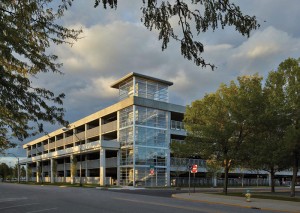American Structurepoint, Inc. was an Award Winner for the Cummins Parking Structure project in the 2013 NCSEA Annual Excellence in Structural Engineering awards program (Category – New Buildings $10M to $30M).
A parking structure that is aesthetically pleasing, built in a historic architecturally iconic downtown, and constructed at 63 percent of the national average cost is hard to achieve, but this is exactly what was accomplished in Columbus, Indiana.
Cummins, Inc. knew it would be expanding the offices of its global corporate headquarters and adding a new parking structure in downtown Columbus. Since the city of Columbus is rated in the top ten of the most architecturally significant cities in the country, this announcement drew some concerns from local officials that a large structure may not mesh well with the existing adjacent buildings.
With the help from architects and engineers of Indianapolis-based consulting firm American Structurepoint (in association with KRJDA), Cummins was able to present a plan to city officials that attracted positive attention. Their parking structure would feature a “living” exterior that promised to blend the new project into the downtown architecture. Cummins received city approval to construct their 954-space, 291,300-square-foot parking structure. The parking structure was designed by American Structurepoint and built by F.A. Wilhelm Construction Co., Inc., of Indianapolis.
A “green screen” on two sides of the five-story structure is perhaps the most unique feature of this parking structure. The modular green wall system adds 7,000-square-feet of living, growing vines that take cues from the original concepts utilized in the landscape and architecture of Cummins’ nearby award-winning headquarters building. The green screen system softens the two facades and adds beauty and visual interest. It also addresses the city’s requirements that vehicles parked within not be visible from the street. The system’s galvanized steel frames create a wonderful composition and rhythm, which reflect the staccato effect of window and door openings found in many of the adjacent urban buildings. They also help filter direct sunlight and shield views of the cars from the street and adjacent buildings.
Self-contained planters support long-term mass vine growth. The insulated containers feature a heat trace wire system designed to prevent root damage during cold temperatures, as well as an automatic irrigation system that detects when the growing medium is dry and provides water as needed. The community will watch the structure literally grow through the years, as its vines fill in and expand. Its appearance will constantly be changing, adding to its visual interest to those who see it develop.
Cummins also desired an open, secure, and cost-effective parking structure. Openness was achieved by utilizing a moment frame lateral load resisting system in lieu of shear walls. Security was aided by providing full glass facades at each stair tower. The overall parking structure expressed its aesthetics principally through exposing structural elements and enhancing them. This approach allowed for a cost-effective and visually pleasing parking structure.
Two-way, cast-in-place, post-tensioned concrete slabs form the two stair tower roofs, with the roof of the southwest stair tower cantilevering more than seven feet in all directions from a central concrete core wall. Precast concrete stairs were used in a unique manner by cantilevering from a central concrete core wall. This created a lighter, open feel to the stair tower element by reducing the size of the external structure. The effect is a gentle stepped slope wrapping around the core and a secure feeling with unobstructed penetrating exterior light. A 20-foot-tall white precast concrete trellis ties into the west elevation, matching the adjacent iconic headquarters building concrete trellis and creating an approachable, pedestrian-friendly walkway and a framework for vegetation.
Adhering to sustainable design principles for the project, a post-tensioned one-way slab and beam system was chosen for its excellent performance in this aggressive environment. One of the governing design parameters was durability over time, specifically in regards to corrosion. To address this issue, American Structurepoint implemented a multi-pronged approach to maximize building life, including utilizing high-strength concrete with low water/cement ratio; epoxy coated reinforcing, additional concrete cover, post-tensioned tendon and anchorage protection, higher prestress levels to reduce cracking, smaller drainage areas and selective admixtures and sealers to inhibit corrosion. With all of these pieces considered together, the design life of the structure is significantly greater than a typical precast or mild reinforced parking structure.
The overall cost of the structure came in at about $10,600 per parking space. The national average at the time of construction was around $16,700 per parking space. The design provides superior quality and durability for an exceptional price. The parking structure opened in September 2012, after only nine months of construction. It’s now literally a living part of the architectural fabric of downtown Columbus.▪

